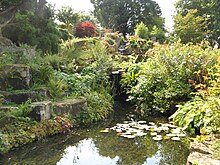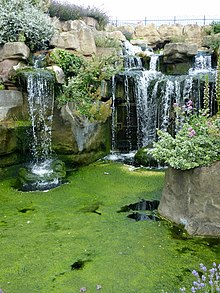Rock garden
Until the fairly recent past the removal for gardening purposes of both plants and stone from their natural wild locations has resulted in considerable problems, and many are now legally protected; English Westmorland limestone pavement is one example.[3] Initially European artificial rockeries did not attempt to mimic natural scenes, and used exotic minerals such as feldspars, lava, and shells, with the plants chosen without a programme, though often including ferns.[4] During the Golden Age of Botany (early 1700s – mid-1800s), there was widespread interest in exotic plants imported to England and other European countries.[5] Although others had previously written about growing alpine plants, a major work was Reginald Farrer's 1919 publication of his two-volume book, The English Rock Garden.[6] When quarrymen threw rocks at her during events campaigning for votes for women, British suffragette Norah Balls picked the stones up and put them in her bag to take home to add to her rockery.


Rock garden (disambiguation)Rockery (disambiguation)RHS WisleyCastle ArchdaleMaibaraShiga prefecturegardenAlpine plantsalpine gardensoutcropsbedrockbedding planelandscape architectslandscapingJapanese rock gardendry gardenWestmorlandlimestone pavementChineseJapanese gardensscholar's rockslimestoneSuseoksuisekifeldsparsshell grottoPulhamiteRamsgateartificial stoneconcreteJames Pulham and SonReginald FarrersuffragetteNorah BallsThailandplastic linerswoodland rock gardenDaisen-inUniversity of AlbertaEdmontonVatican CitysucculentsKew GardensHagiwara Japanese Tea Gardentea gardenSan FranciscoLingnanrockeryZhan YuanGuangdongList of garden typesRock Garden, ChandigarhChandigarhNek ChandGeoffrey JellicoeSusan JellicoeUglow, JennyHorticulturegardeningAllotmentArboretumButterflyClimate-friendly gardeningCommunityForestFoodscapingFrench intensiveGarden designcomputer-aidedGroundskeepingGarden toolGreen wallGuerrillaHistoric conservationHistoryNativeParterrePropliftingRaised bedSquare footSustainableXeriscapingTypes ofgardensAlpineAncient EgyptAustralianBaroqueBiblicalBotanicalBottleByzantineCactusColonialCommunalGarden squareContainerCottageEast AsianCantoneseJapaneseKoreanVietnameseEnglishSharawadgiFerneryFloatingFlowerformallandscapeRenaissanceGermanGreenhouseHangingIslamicItalianKeyholeKitchenMarketMedievalMonasticMughalOrchardIndonesian home gardenPersianCharbaghParadise
